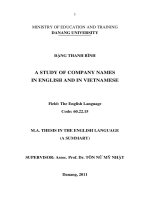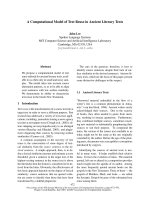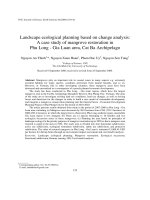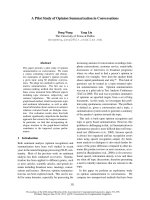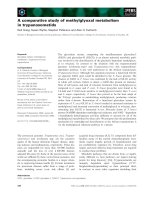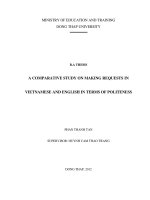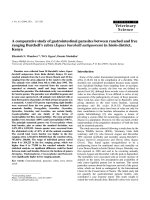A COMPUTATIONAL STUDY OF FREE RADICALS IN CHEMISTRY AND BIOLOGY
Bạn đang xem bản rút gọn của tài liệu. Xem và tải ngay bản đầy đủ của tài liệu tại đây (4.44 MB, 219 trang )
A COMPUTATIONAL STUDY OF FREE RADICALS IN
CHEMISTRY AND BIOLOGY
ADRIAN MATTHEW MAK WENG KIN
(B.Sc.(Hons.)), NUS
A THESIS SUBMITTED
FOR THE DEGREE OF DOCTOR OF PHILOSOPHY
NUS GRADUATE SCHOOL OF INTEGRATIVE SCIENCES AND
ENGINEERING
NATIONAL UNIVERSITY OF SINGAPORE
2007
Abstract
Free radicals are involved in many aspects of our daily lives, but due to their transient
nature and high reactivity, many free radicals and free radical precursors prove
difficult to study experimentally. The use of computational quantum chemical
methods to study these intriguing molecules has become popular today, given the
increasing availability and lowering cost of computing power. In this work,
computational studies on two families of reactive species are presented. First, a study
on intermediate species formed from the action of nitric oxide, NO•, with particular
emphasis on the direct effects of the free radical precursor peroxynitrite, ONOO–, and
the second, a study of bis(thiocarbonyl)disulfides (RCS2)2 in industrial sulfur
vulcanization of rubber, in particular, tetramethylthiuram disulfide (TMTD).
Knowledge of the intricate chemistry behind these reactive species will be useful in
designing experiments in this area, and better understanding of the way they work in
nature can thus be achieved.
ii
Acknowledgements
The greatest thanks go to God, without whom all this would not have been possible.
Next, I am grateful to my family and Juliana, for being by my side as sound pillars of
support; for being there for me when I needed them most.
To Dr. Richard Wong, my thesis supervisor, thanks for the knowledge imparted to
this student of yours, and for being so much more than just a mere supervisor to me,
and also to my co-supervisor Dr. Matt Whiteman, for his valuable advice and help
along the way. Many thanks also go to Prof. Ralf Steudel and Dr. Yana Steudel of
Technical University of Berlin for opportunities in collaborative work.
Thanks goes to the Agency for Science, Technology and Research (A*STAR) for
providing the funding for graduate study, and the opportunity for a brighter future. To
those at NGS, here’s a big ‘thank you’ for your efficiency in administering to us
graduate students.
I am thankful for the many friends I made throughout the course of my study in the
Molecular Modeling Laboratory. To my friends, Henry, Jason, Ted, St. Francis Music
Ministry, Nicholas, Sabrina, Paul, Celene, Mr. & Mrs. Kodama, I am grateful to you,
for cheering me on.
Thank you, Mother Mary, for praying for me.
iii
Dedicated to my late grandfather.
iv
List of Publications Included in this Thesis
The following papers were published as a direct consequence of the work undertaken
in this thesis:
1.
Thermochemistry of Reactive Nitrogen Oxide Species and Reaction
Enthalpies for Decomposition of ONOO– and ONOOH.
Mak, A. M.; Wong, M. W. Chem. Phys. Lett. 2005, 403, 192.
2.
Homolytic Dissociation of the Vulcanization Accelerator
Tetramethylthiuram Disulfide (TMTD) and Structures and Stabilities of
the Related Radicals Me2NCSn• (n = 1–4).
Steudel, R.; Steudel, Y.; Mak, A. M.; Wong, M. W. J. Org. Chem. 2006, 71,
9302.
3.
Reaction of the Radical Pair NO2• and CO3•– with 2-[6-(4′Amino)phenoxy-3H-xanthen-3-on-9-yl]benzoic Acid (APF).
Mak, A. M.; Whiteman, M.; Wong, M. W. J. Phys. Chem. A, 2007, 111, 8202.
v
Table of Contents
Abstract
ii
Acknowledgements
iii
Table of Contents
vi
Summary
Xi
List of Tables
1
List of Figures
4
List of Reaction Schemes
7
1. Introduction
8
2. Theory and Methodology
16
2.1 Introduction
16
2.2 The Schrödinger Equation
16
2.3 Time-independence
17
2.4 The Hamiltonian Operator
18
2.5 Atomic Units
19
2.6 Born-Oppenheimer Approximation
19
2.7 Hartree-Fock Method
20
2.7.1 The Wave Function Φ as a Slater Determinant
20
2.7.2 Basis Sets
21
2.7.3 The Variation Principle
24
vi
2.7.4 The Fock Matrix
25
2.7.5 The Roothaan-Hall Equations
25
2.8 Restricted and Unrestricted Hartree-Fock Methods
27
2.9 Correlation Effects
29
2.9.1 Configuration Interaction (CI)
30
2.9.2 Limited Configuration Interaction
31
2.9.3 Coupled Cluster Methods
31
2.9.4 Møller-Plesset Perturbation Theory
32
2.10 Multi-Configuration SCF
34
2.11 Density Functional Theory
35
2.11.1 Local Density Approximation (LDA) and Local Spin Density
Approximation (LSDA)
36
2.11.2 Generalized Gradient Approximation (GGA)
37
2.11.3 Hybrid Functionals
39
2.12 Composite Methods for Accurate Thermochemistry
40
2.12.1 Gaussian-n Methods
40
2.12.2 CBS-n Methods
43
2.13 Methods of Calculation of ESR G-shifts
45
2.14 Solvation Models
46
2.14.1 Onsager Reaction Field Theory
47
2.14.2 Integral Equation Formalism for Polarizable Continuum
Solvent Model (IEFPCM)
3. Thermochemistry of Reactive Nitrogen Oxide Species
3.1 Introduction
48
55
55
vii
3.2 Computational Methods
57
3.3 Results and Discussion
59
3.3.1 Enthalpies of Formation of RNOS
59
3.3.2 Enthalpies of Reactions Involving ONOO– and ONOOH
Decomposition
3.4 Conclusion
66
68
4. Decomposition of Nitrosoperoxycarbonate Anion: Gas Phase and
Solvent Modeled Studies
73
4.1 Introduction
73
4.2 Computational Methods
75
4.3 Results and Discussion
77
4.3.1 Gas-phase Reaction Profile of ONOO– Reaction with CO2
77
4.3.2 Implicit Solvation Model (ISM) Results
82
4.3.3 Explicit Solvation Model (ESM) Results
84
4.3.4 Hybrid Solvation Model (HSM) Results
89
4.3.5 UV-Visible Spectra of ONOO–, ONOOCO2– and CO3•–
91
4.4 Concluding Remarks
95
5. Reaction of the Radical Pair NO2• and CO3•– with 2-[6-(4′Amino)phenoxy-3H-xanthen-3-on-9-yl]benzoic Acid (APF)
100
5.1 Introduction
100
5.2 Methods
103
5.2.1 Computational Methods
103
5.2.2 Experimental Methods
104
viii
5.3 Results and Discussion
106
5.3.1 Influence of HCO3− concentration on ONOO− mediated
oxidation of APF
106
5.3.2 Gas Phase Calculations
107
5.3.3 Solvent Effects
118
5.4 Concluding Remarks
118
6. Homolytic Dissociation of the Vulcanization Accelerator
Tetramethylthiuram Disulfide (TMTD) and Structures and Stabilities of
the Related Radicals Me2NCSn• (n = 1−4)
125
6.1 Introduction
125
6.2 Computational Methods
127
6.3 Results and Discussion
129
6.3.1 Structures and Stabilities of Tetramethylthiuram Sulfides and
Their Related Radicals
129
6.3.2 Impact of Metal Cations on the Dissociation of
Tetramethylthiuram Di- and Trisulfides
6.4 Concluding Remarks
143
153
7. Dissociation Enthalpies and Activation Barriers of Various
Bis(thiocarbonyl)disulfides R–C(=S)–S–S–C(=S)–R
159
7.1 Introduction
159
7.2 Computational Methods
162
7.3 Results and Discussion
163
7.3.1 Substituted bis(thiocarbonyl)disulfides, R = H, Me, F, Cl, OMe,
164
ix
SMe, NMe2, PMe2
7.3.2 Novel bis(thiocarbonyl)disulfides, R = OSF5, Gu1, Gu2
7.4 Concluding Remarks
Appendix 1
174
180
183
x
Summary
Free radicals are isolated atoms or molecules that possess one or more unpaired
electrons, and are capable of independent existence. Electrons within an atomic or
molecular system seek to be paired with another electron with opposite spin, resulting
in stable electronic configurations. Free radicals can react readily with many
molecules, in a myriad of mechanisms.
The study of free radicals is an interest of many research groups worldwide. This
comes as no surprise, since radicals play important roles in many chemical and
biological processes. For instance, nitric oxide (NO•) and superoxide (O2•–) play
important roles in biochemical pathways, triplet oxygen (O2) is a biradical that is
essential in combustion processes, benzoyloxyl radicals (PhCOO•) are used as
initiators in radical polymerization processes. Since most free radicals and free radical
precursors are transient by nature, the experimental study of them is challenging. The
enormous computing power available in the present day allows the use of
computational methods to study the chemistry of these intriguing compounds.
The work described in this thesis is based on computational studies of the molecular
properties, reactions and hence chemistry of free radicals and is centered on two
themes. The first is the study of reactive nitrogen species (RNS) and reactive oxygen
species (ROS), particularly those involving intriguing free radical precursor
peroxynitrite, ONOO–. The thermochemistry of reactions involving peroxynitrite was
evaluated and reviewed using high level ab initio and composite methods. As the
xi
most likely compound to react directly with ONOO– is CO2, a solvation study to
provide insight into solvent effects on the energetics and mechanisms of this reaction
was attempted, and its results presented. The detection and quantitation of RNS such
as ONOO– is carried out in a number of ways, of which, one method involves the use
of a pre-fluorescent probe in vivo in vitro. The mechanism of reaction of ONOO– with
such a fluorescent probe, APF, was studied, to provide a better picture of the reactive
species directly responsible for oxidation of the probe.
The second theme in this thesis is the study of bis(thiocarbonyl)disulfides (RCS2)2 and
thiocarbamate radicals RCS2• in the sulfur vulcanization of rubber. A theoretical study
on the energetics, molecular structures and properties of the intermediates involved in
tetramethylthiuram disulfide (TMTD) mediated sulfur vulcanization is presented.
Also presented is an exploration of novel bis(thiocarbonyl)disulfides to examine their
feasibility as alternatives to TMTD.
xii
List of Tables
Page
Table 2.1. Components of CBS-4, CBS-q, CBS-Q, CBS-QCI/APNO,
G3(MP2) and G3 models.
45
Table 3.1. Calculated standard enthalpies of formation (ΔH°f,298, kJ
mol–1) of sixteen RNOS using various Gaussian-n methods.
60
Table 3.2. Calculated standard enthalpies of formation (ΔH°f,298, kJ
mol–1) of sixteen RNOS using various CBS methods.
61
Table 3.3. Selected calculated bond lengths of RNOS in Ångstroms.
62
Table 3.4. Calculated structural parameters of planar cis-peroxynitrite,
ONOO–, at various levels of theory.
64
Table 3.5. Calculated reaction enthalpies, in kJ mol–1, for reactions (1)
to (3) at 298 K.
67
Table 4.1. Zero point corrected relative energies of 1-7, TS1 and TS2,
in kJ mol–1.
82
Table 4.2. B3LYP/6-311+G(2df,p)//B3LYP/6-31+G(d) + ZPE and
spin correction relative energies of 1-7, TS1 and TS2, in kJ mol–1,
using implicit solvation models (ISM).
82
Table 4.3. B3LYP/6-311+G(2df,p)//B3LYP/6-31+G(d) + ZPE + Spin
correction relative energies of 1a-7a, TS1a and TS2a, in kJ mol–1,
using the explicit solvation model (ESM).
85
Table 4.4. B3LYP/6-311+G(2df,p)//B3LYP/6-31+G(d) + ZPE + Spin
correction relative energies of 1a-7a, TS1a and TS2a, in kJ mol–1,
using the hybrid solvation model (HSM).
89
Table 4.5. Predicted UV-vis absorption bands of cis-ONOO– (1),
trans-ONOO– (2), cis-ONOOCO2– (4), trans-ONOOCO2– (5), and
CO3•– (7) using various methods, based geometry obtained at
B3LYP/6-31+G(d) level.
91
Table 4.6. Calculated UV-Visible excitation wavelengths λexcitation, and
corresponding oscillator strength values, of CO3•– with 0, 1 and 2
explicit H2O molecules, and incorporating IEFPCM for modeling bulk
effects of an aqueous solvent, using the TD-B3LYP method and the
aug-cc-pVTZ basis set.
94
1
Table 5.1. Calculated activation barriers (kJ mol–1) of the two reaction
pathways in the gas phase and in a polar medium at the MPW1K/6311+G(d,p)//MPW1K/6-31G(d) level.
119
Table 6.1. Calculated Reaction Enthalpies (∆H°298, kJ mol–1) Using
the G3X(MP2) and G3X(MP2)-RAD Methods.
135
Table 6.2. NBO Atomic Charges of the Donor Atoms and Dipole
Moments μ in Debye of Species 1–4, 7, 7a and 7b.
139
Table 6.3. Binding energies, in kJ mol–1, and dipole moments μ, in
Debye, of the lithium complexes 8–12, 14 and 15. Energies
correspond to G3X(MP2) values, and dipole moments are calculated
at the B3LYP/6-31G(2df,p) level.
146
Table 7.1. Selected calculated bond lengths (in Ångstroms) of
(RCS2)2. Molecular geometry was optimized at the B3LYP/631G(2df,p) level of theory. Average experimental values for C—R
bond lengths are included for comparison.
165
Table 7.2. Selected bond lengths (in Ångstroms) of RCS2•. Molecular
geometry was optimized at the B3LYP/6-31G(2df,p) level of theory.
167
Table 7.3. ∆H°298 and ∆G°298 for the homolytic S—S bond
dissociation reaction (RCS2)2 → 2 RCS2• calculated at the G3X(MP2)
level of theory.
168
Table 7.4. NBO charges of (RCS2)2 and RCS2•, evaluated at the
B3LYP/6-31G(2df,p) level of theory, for substituents R = H, Me, F,
Cl, OMe, SMe, NMe2 and PMe2.
169
Table 7.5. Selected calculated bond lengths (in Ångstroms) of
[Li(RCS2)2]+. Molecular geometry was optimized at the B3LYP/631G(2df,p) level of theory.
170
Table 7.6. Selected calculated bond lengths (in Ångstroms) of
[Li(RCS2)]•+. Molecular geometry was optimized at the B3LYP/631G(2df,p) level of theory.
170
Table 7.7. Selected calculated bond lengths (in Ångstroms) of triplet
[(RCS2)Li(S2CR)]+. Molecular geometry was optimized at the
B3LYP/6-31G(2df,p) level of theory.
171
Table 7.8. ∆H°298 and ∆G°298 for the coordination of (RCS2)2 and
RCS2• to Li+ in kJ mol–1, calculated at the G3X(MP2) level of theory.
172
Table 7.9. ∆H°298 and ∆G°298 for the reactions [Li(RCS2)2]+ →
[Li(RCS2)]•+ + (RCS2)•, [Li(RCS2)2]+ → [(RCS2)Li(S2CR)]+, and
[Li(RCS2)2]+ + Li+ → 2 [Li(RCS2)]•+ in kJ mol–1, calculated at the
G3X(MP2) level of theory.
173
2
Table 7.10. Zero-point corrected reaction energies (∆E0) for the
reaction (RCS2)2 → 2 RCS2• , in kJ mol–1, for R = NMe2, OSF5, Gu1
and Gu2.
176
3
List of Figures
Page
Figure 2.1. A graphical representation of the variation of the energy
of the 1s electron with its distance from the nucleus using a Slater type
orbital (STO) basis function and a Gaussian type basis function (STO3G basis set).
23
Figure 2.2. Flowchart summary of the procedure for solving the
Roothaan-Hall equations.
27
Figure 2.3. Graphical representation of electron placement in orbitals
following the RHF, UHF and ROHF formalisms.
29
Figure 2.4. Schematic diagram of electron correlation versus size of
basis set.
34
Figure 2.5. A graph of eij(N) versus (N + δ)–1 for the helium PNOs.
44
Figure 3.1. Structures, element numbering, state and symmetry
symbols of the sixteen RNOS: NO•, NO+, NO–, HNO, NO2•, NO2+,
NO2–, HNO2, N2O, NO3•, ONOO–, ONOOH, NOCl, NO2Cl, N2O3,
N2O4.
57
Figure 4.1. Structures of local minima 1-7, TS1 and TS2, calculated
at the B3LYP/6-31+G(d) level. Distances are given in Ångstroms.
79
Figure 4.2. Highest occupied molecular orbital (HOMO) of cisONOO– calculated at the B3LYP/6-31+G(d) level, showing extent of
π*–π* interaction.
80
Figure 4.3. Structures of local minima 1a, 2a, 3a, 6a and 7a,
calculated at the B3LYP/6-31+G(d) level. Distances are given in
Ångstroms.
86
Figure 4.4. Structures of local minima 4a and 5a, and transition states
TS1a and TS2a, calculated at the B3LYP/6-31+G(d) level. Distances
are given in Ångstroms.
87
Figure 5.1. Plot of percentage yield of fluorescein, relative to ONOO–,
versus the concentration of HCO3– in the reaction mixture.
107
Figure 5.2. Calculated structural parameters of dianionic fluorescein
(2E), neutral fluorescein, at the MPW1K/6-31G(d) level in the gas
phase. X-ray crystal structural parameters are included for
comparison.
110
4
Figure 5.3. Schematic gas-phase reaction energy profile for step 1 of
pathway I, calculated at the MPW1K/6-311+G(d,p)//MPW1K/631G(d) +ZPE level with spin correction.
111
Figure 5.4. Schematic gas-phase reaction energy profile for step 2 of
pathway I, calculated at the MPW1K/6-311+G(d,p)//MPW1K/631G(d) +ZPE level with spin correction.
113
Figure 5.5. Schematic gas-phase reaction energy profile for pathway
II, calculated at the MPW1K/6-311+G(d,p)//MPW1K/6-31G(d) +ZPE
level with spin correction.
114
Figure 5.6. MPW1K/6-31G(d) optimized geometries of 1A, 1B, 1D
and 1E. Distances shown are in Ångstroms. Non essential hydrogens
are omitted for clarity.
115
Figure 5.7. MPW1K/6-31G(d) optimized geometries of 2B, 2D, 3B
and 3D. Distances shown are in Ångstroms. Non essential hydrogens
are omitted for clarity.
116
Figure 5.8. MPW1K/6-31G(d) optimized geometries of transition
structures TS1C, TS2A, TS2C, TS3A and TS3C. Distances shown
are in Ångstroms. Non essential hydrogens are omitted for clarity.
117
Figure 5.9. Atom numbering scheme for 1A, 1E, TS2C and TS3C.
118
Figure 6.1. Chemical structure of tetramethylthiuram disulfide
(TMTD).
125
Figure 6.2. B3LYP/6-31G(2df,p) optimized geometries of the two
conformers of TMTD. Distances are in Ångstroms.
130
Figure 6.3. B3LYP/6-31G(2df,p) optimized geometries of the radicals
Me2NCSn• (n = 1–3). Distances are in Ångstroms.
131
Figure 6.4. UB3LYP/6-31G(2df,p) spin density plots of the Me2NCSn•
radicals (n = 1–3)
132
Figure 6.5. Chemical drawing of 2, showing resonance structures.
132
Figure 6.6. B3LYP/6-31G(2df,p) optimized geometries of the
conformers of the Me2NCS4• radical, 7, 7a and 7b, together with the
numbering convention of sulfur atoms. Distances are given in
Ångstroms.
139
Figure 6.7. UB3LYP/6-31G(2df,p) spin density plots of 7, 7a and 7b.
140
Figure 6.8. B3LYP/6-31G(2df,p) optimized geometries of TMTU,
TMTM and TMTT. Distances are in Ångstroms.
142
5
Figure 6.9. B3LYP/6-31G(2df,p) optimized geometries of the cationic
lithium complexes [Li(TMTD)]+ (8), [Li(SCNMe2)]•+ (9),
[Li(S2CNMe2)]•+ (10) and [Li(S3CNMe2)]•+ (11). Distances are in
Ångstroms.
Figure 6.10. B3LYP/6-31G(2df,p) optimized geometry of the triplet
lithium complex [Li(S2CNMe2)2]+. Distances are given in Ångstroms.
144
148
Figure 6.11. Schematic energy level diagram for the homolytic
dissociation and complex formation reactions of TMTD with and
without Li+ cations, based on G3X(MP2) computed reaction
enthalpies.
149
Figure 6.12. B3LYP/6-31G(2df,p) optimized geometries of the triplet
species 13 and 15 and singlet species 14. Distances are given in
Ångstroms.
152
Figure 7.1. Examples of different sulfur vulcanization reagents
commercially available.
160
Figure 7.2. The homolytic dissociation of (RCS2)2 with novel
substituents R.
162
Figure 7.3. Typical structures of (RCS2)2, RCS2•, [Li(RCS2)2]+,
[Li(RCS2)]•+ and triplet [(RCS2)Li(S2CR)]+.
164
Figure 7.4. The B3LYP/6-31G(2df,p) optimized structure of
(Me2PCS2)2, showing the lack of planarity at the C2PCS2 framework.
166
Figure 7.5. UB3LYP/6-31G(2df,p) spin density plots of the radicals
RCS2•.
167
Figure 7.6. B3LYP/6-31G(d) optimized structures of (F5SOCS2)2,
((Gu1)CS2)2 and ((Gu2)CS2)2. Distances are in Ångstroms.
175
Figure 7.7. B3LYP/6-31G(d) optimized structures of F5SOCS2•,
(Gu1)CS2• and (Gu2)CS2•. Distances are in Ångstroms.
176
Figure 7.8. Schematic potential energy profile of the homolytic S—S
bond dissociation reaction (RCS2)2 → 2 RCS2•, for R = NMe2, OSF5,
Gu1 and Gu2, calculated at the MP2/6-311+G(d,p)//B3LYP/6-31G(d)
+ ZPE level of theory. Relative energies are given in parentheses.
178
6
List of Reaction Schemes
Page
Scheme 4.1. Proposed reaction scheme and labeling of various species
involved in the reaction ONOO– + CO2 → ONO−OCO2– → NO2• +
CO3•–.
77
Scheme 5.1. Action of RNS on APF.
102
Scheme 5.2. Pathway I of APF oxidation.
109
Scheme 5.3. Pathway II of APF oxidation.
109
7
Chapter One
Introduction
Free radicals are commonly defined as atomic or molecular species that possess one
or more unpaired electrons (i.e. nonzero spin), and are capable of independent
existence. These free radicals and other highly reactive closed-shell (i.e. all electrons
paired) molecules form a collective group known as reactive species (RS). The
considerable importance of RS in chemistry and biology has come to light only within
the last few decades, upon the realization that these RS are part of important chemical
reactions in the atmosphere, in industrial processes and in the human body. It is
certainly remarkable to see how free radical chemistry is involved in much of our
daily lives, for instance, the destruction of the ozone layer surrounding our planet, the
industrial preparation of plastics, and in cellular respiration and signaling [1].
Free radicals can be studied in a number of ways. Experimental methods employed to
study them include infra-red (IR) spectroscopy, mass spectrometry (MS), electron
paramagnetic resonance (EPR, also known as electron spin resonance, ESR), pulse
radiolysis and high speed electrochemistry [2]. Aside from these experimental
methods, ab initio or density functional theory calculations can be employed to study
the geometries, energies and hence molecular properties of these radicals in question.
The emergence of the field of computational chemistry followed the formulation and
development of quantum theory in the early twentieth century. Calculations based on
the fundamental principles that govern the behavior of chemical systems can be
8
carried out to determine their physical and chemical properties, thus revolutionizing
our understanding of physics and chemistry. Given the transient nature of most RS,
the use of computational tools to study their electronic structure has become a popular
method of scientific inquiry [3, 4]. We can now predict the structural and hence
molecular properties of these RS to a reasonably good degree of accuracy.
Chapter two of this thesis describes the theoretical framework behind the methods
employed in each topic, namely the ab initio methods, density functional methods,
and basis sets. The calculation of molecular properties such as thermochemistry and
electron spin resonance is briefly touched on in this chapter as well.
Following the description of the theoretical framework and methodology, the rest of
the work described in this thesis centers around two themes. First is the study of
reactive nitrogen and oxygen species that result from reactions of nitric oxide (NO•),
and the second, the study of bis(thiocarbonyl) disulfides ((RCS2)2) and related radicals
involved in the vulcanization of rubber by sulfur and sulfur-rich compounds.
Despite their reputation for causing damage, many biological processes are found to
be mediated by free radicals. The discovery of NO• as a biological mediator is
credited to the 1998 winners of the Nobel Prize for Physiology or Medicine:
Furchgott, Ignarro and Murad. Murad first observed in 1977 that NO• activates an
enzyme guanylyl cyclase and activates smooth muscle relaxation [5, 6]. Ignarro made
two key observations – that NO• has an effect of relaxing an artery [7] and this same
gas inhibits platelet aggregation and activates the cellular messenger cyclic guanosine
monophosphate (cGMP) [8]. Furchgott observed that the endothelium in smooth
9
muscles releases a factor, tentatively named endothelium-derived relaxing factor
(EDRF) that causes vasodilation [9]. It was established in 1986 that EDRF and NO•
are one and the same [10, 11]. This was a surprising discovery, given that during that
time, NO• was believed to be an atmospheric pollutant and little else.
The free radical NO• is formed by the action of nitric oxide synthases (NOS) on the
amino acid L-arginine [12], and can react with a host of other molecules to form
reactive nitrogen species (RNS). For instance, NO• can combine with superoxide
(O2•−), a free radical produced by phagocytic cells, to form peroxynitrite (ONOO–), an
essential precursor of other RNS such as NO2•. The direct and indirect effects of NO•
are diverse and can be cytoprotective, regulatory or cytotoxic [13-15]. Such diverse
effects of RNS sparked off tremendous research interest by many research groups
worldwide to better understand their biological behavior.
In chapter three, the thermochemistry of a series of biologically relevant reactive
nitrogen oxide species (RNOS) is discussed. The standard enthalpies of formation at
298K of NO•, NO+, NO–, HNO, NO2•, NO2+, NO2–, HNO2, N2O, NO3•, ONOO–,
ONOOH, NOCl, NO2Cl, N2O3, and N2O4 were computed using various composite
methods, namely the Gaussian-n (Gn) and complete basis set extrapolation (CBS)
methods, and the standard enthalpies of decomposition reactions involving ONOO–
and ONOOH were investigated at various levels of theory, namely the composite
methods mentioned above, and coupled-cluster theory. The goal of this work is to find
a suitable method that can well describe the thermochemistry of such nitrogencentered RS, and predict the standard heats of formation of ONOO– and ONOOH
which have not been experimentally ascertained.
10
A study on the effects of solvation on the reaction of cis- and trans-ONOO– with CO2
is described in chapter four. Formation of the nitrosoperoxycarbonate anion,
ONOOCO2–, and its subsequent decomposition into NO2• and CO3•− free radicals have
been attributed as a source of free radicals in biological systems [16]. A
computational study of the above reaction using density functional theory was carried
out, to gain some chemical insight on the influence of an aqueous solvent on the
energetics involved. In addition, the transition energies of the RS ONOO–,
ONOOCO2–, and CO3•− were investigated using a variety of theoretical methods, to
substantiate the assignments of their experimental UV absorption bands.
The detection and quantitation of RNS and reactive oxygen species (ROS) remains a
constant challenge to many scientists today. The use of fluorescent probes in various
assays is the most common method used today for such purposes. 2-[6-(4′Amino)phenoxy-3H-xanthen-3-on-9-yl]benzoic acid or 4-aminophenylfluorescein
(APF), developed by Setsukinai et al in 2003 [17], displayed excellent selectivity for
the RNS ONOO– over other RS such as superoxide (O2•−) and hydrogen peroxide
(H2O2). The mechanism of APF reaction with species related to ONOO– reaction with
CO2 was investigated, using a combination of experimental and computational
methods, to determine the identities of the species directly involved in the twoelectron oxidation of the probe, and the energetics involved. This work is described in
chapter five of this thesis.
Other than the involvement of free radicals in biological systems, free radicals have
also been employed in organic synthesis [18, 19] and other industrial applications.
11
Aside from being used for free radical chain substitution reactions in hydrocarbons
and free radical polymerization – common topics in most high school chemistry
textbooks – free radicals are also involved in functional group transformation (e.g.
decarboxylation, deamination, halogen reduction) [20], cyclization reactions and
aromatic substitutions. Reactive precursors such as bromine gas, tributyltin hydride
(Bu3SnH), and 2,2′-azobis(2-methylpropionitrile) (AIBN) are used to generate free
radicals in situ for such applications in organic synthesis. Free radicals can also be
used in cross-linking polymerization, of which one major industrial application would
be the sulfur vulcanization of rubber.
Sulfur vulcanization of rubber involves sulfide and disulfide cross-link generation
across neighboring poly(cis-isoprene) chains using elemental sulfur and accelerators
such as tetramethylthiuram disulfide (TMTD), thus providing strength to the overall
molecular structure. TMTD, having a formula (CH3)2NC(=S)SSC(=S)N(CH3)2 can be
thought of as a ‘reactive precursor’ as mentioned above, where the free radical
(CH3)2NCS2• is generated in situ. The cross-linking process is believed to take place
via various radical pathways. A detailed examination of the homolytic dissociation of
TMTD and the radicals involved in this process is described in chapter six. In addition,
the chemistry surrounding coordination of TMTD and associated radicals with a
lithium cation is explored. The thermochemistry surrounding their reactions are
derived using high-level composite methods, and calculation of molecular properties
such as spin density and electron spin resonance spectra are also covered in this study.
The work done in this chapter is a collaborative effort with Professor Ralf Steudel and
Dr. Yana Steudel from the Institute of Chemistry in the Technical University of Berlin.
12
While TMTD is already an adequate choice for an accelerator in rubber vulcanization,
there is still reliance on zinc oxide to facilitate the formation of thiocarbamoyl
radicals RCS2• as the homolytic S—S bond dissociation enthalpy in room temperature
conditions is about 150 kJ mol–1. In chapter seven, an exploration of other substituted
bis(thiocarbonyl) disulfides (RCS2)2 is attempted, to find suitable alternative rubber
vulcanization accelerators. The homolytic S—S bond dissociation enthalpy of
(RCS2)2, and coordination enthalpy of Li+ ions to (RCS2)2 and RCS2• for R = H, Me, F,
Cl, OMe, SMe, NMe2 and PMe2 were studied and compared. Additionally, the S—S
bond dissociation enthalpy and activation barriers for a number of novel substituents
R were examined, in an effort to find suitable substituents with can stabilize the RCS2•
radical and result in a more energetically favorable generation of these radicals.
References
1.
Parsons, A. F., An Introduction to Free Radical Chemistry. Blackwell Science:
Oxford, 2000.
2.
Fossey, J.; Lefort, D.; Sorba, J., Free Radicals in Organic Chemistry. Masson:
Paris, 1995.
3.
Anders, M. W.; Yin, H.; Jones, J. P., Application of Computational Chemistry
in the Study of Biologically Reactive Intermediates In Advances in
Experimental Medicine and Biology: Biological Reactive Intermediates V:
Basic Mechanistic Research in Toxicology and Human Risk Assessment,
Snyder, R.; Kocsis, J. J.; Jollow, D. J.; Witmer, C. M.; Greim, H.; Sipes, I. G.;
13
